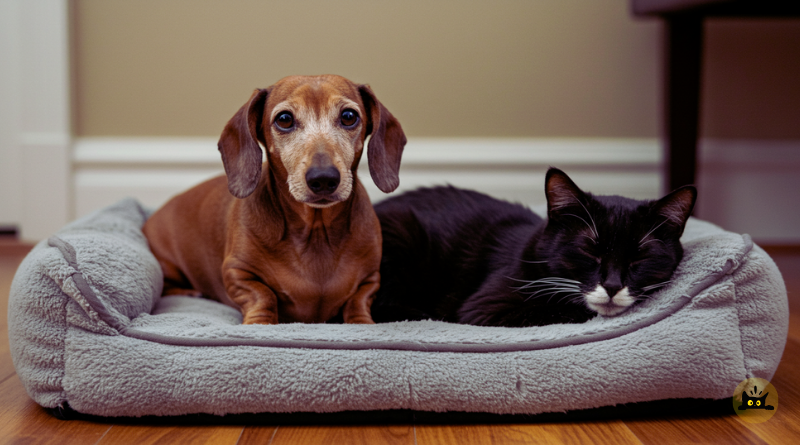Senior pet care tips help as pets grow older they reach a stage that requires extra care to keep them comfy and energetic. Small changes in eating habits, energy, ease of movement and behavior often signal the need for new routines and adjustments. Drawing on expert guidance this article shares simple tips you can take to spot getting-older signs early and change meals, vet trips and home space. By focusing on these practical measures you will help your senior buddy enjoy a happy life.
Senior Pet Care Tips for Spotting Getting-Older Signs
Physical Signs
Senior dogs and cats frequently display changes in fur feel, muscle strength and how easily they move. You may notice a pet hesitating before climbing stairs, walking with a stiffer walk or spending more time lying on cool floors. Such signs can indicate early arthritis, sore joints or weak muscles. British Small Animal Veterinary Association notes that early identification of these issues allows for quick help that slows progression and reduces pain.
Behavior Changes
Behavior changes can include strange sleep patterns, less desire to play, eating slower or making more noise. A cat that once sprang onto furniture may prefer lower surfaces and a dog may no longer chase toys with the same enthusiasm. These changes can come from losing sight or hearing, toothache or just tiredness related to normal aging. Watching these signs helps you make safer spots and change activities to match their abilities.
Health Tips
Regular Vet Visits
As pets enter senior years it is wise to have more vet check-ups. American Veterinary Medical Association recommends twice-yearly health check-ups along with blood and urine tests. Such checks find kidney, heart, teeth or hormone issues long before they become big problems. Early detection creates opportunities for treatments that keep organs working and keep them comfy longer.
Diet Changes
Food plays a crucial role in keeping organs healthy, joints moving and muscles strong. Senior pet foods usually have balanced protein, fewer calories and fish oil to help reduce swelling. Adding things like berries or spinach boosts their immune system. It is important to consult your veterinarian to set feeding rules that avoid too much weight gain or muscle loss as your buddy’s metabolism changes with age.
Home Changes
Making Cozy Spots
Designating floor-level beds helps pets avoid the strain of jumping. A soft bed with a foam layer can ease joint pain while keeping them warm. Raising bowls a bit reduces the need to bend and twist during meals. British Small Animal Veterinary Association highlights that these simple changes promote more restful sleep and greater mobility indoors.
Enhancing Home Safety
Stopping slips and falls protects aging muscles and joints. Placing no-slip mats on tile or hardwood floors in high-traffic areas provides stable footing. A ramp or small steps beside sofas, cars or porch entrances replaces risky leaps with gentle climbs. Keeping essential items such as food, water and litter trays on a single easily reached level prevents extra effort and encourages daily independence.
Daily To-Dos
- Encourage gentle exercise by taking short walks on grass or playing gentle indoor games that match their energy level.
- Weigh your buddy weekly or feel their ribs and back to check muscle to catch trends early.
- Offer drinking water in low, wide bowls placed at multiple spots to ensure easy access for pets with limited mobility.
- Keep their teeth clean with brushing or vet-approved chew toys to prevent toothache that could reduce appetite.
Joint Help & Vitamins
Supplements like glucosamine, chondroitin and fish oil keep joints moving and reduce aches. Pet Poison Helpline warns that quality and amount differ widely so always seek a professional recommendation before starting any new vitamin routine. Careful selection protects your buddy from giving too much or wrong stuff that may cause upset stomach or worse.
Grooming & Skin Help
Older pets may develop dry skin, thin fur and areas of irritation. Brushing once a week helps blood flow while baths with gentle pet shampoo remove loose hair and soothe skin. Look for lumps, bumps or red spots during each session. Using a pet-friendly skin moisturizer can restore moisture and reduce itchiness without harsh chemicals.
Conclusion
Supporting a senior pet demands patience, watching closely and being ready to tweak routines as needs evolve. By spotting physical and behavior changes, having regular vet visits, changing diet, making cozy spots and applying these helpful tips you will boost your buddy’s health and happiness. Implement these tips today to enjoy every moment with your buddy and make their later years comfy and happy.
Sources : British Small Animal Veterinary Association, American Veterinary Medical Association, Pet Poison Helpline
Explore more helpful articles in this category: Silent Pain Signs in Cats and Dogs You Must Know

